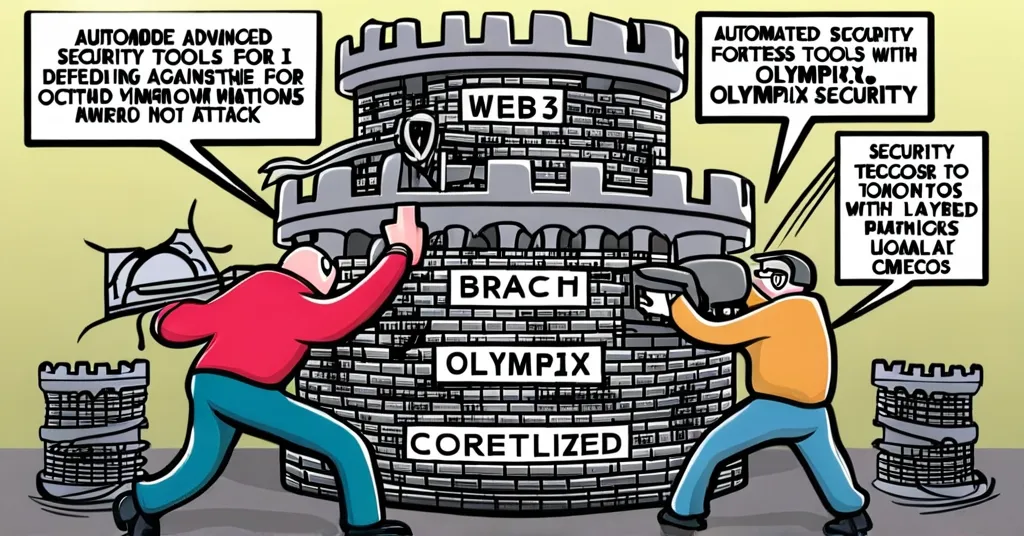Web3 Security Crisis: Manual Audits Fail as Quantum and AI Surge Forward

Our Audit Blindspot: Web3’s Future Depends on Rethinking Security
Web3’s security is lagging behind other technological advancements, putting the entire ecosystem at risk. It’s high time we evolve our security practices to match the pace of innovation.
- Quantum computing and AI advancements in 2024
- Web3 security stuck with manual audits
- Decentralized architecture increases attack surface
- 90% of exploited contracts had audits
- Smart contract immutability complicates security
- Euler Finance hack despite multiple audits
- Olympix automates part of the audit process
- Need for a multi-layered security approach
While quantum computing chips from Google and AI models like AlphaFold push technological boundaries, web3 security remains tethered to outdated manual audit practices. You’d think with all this tech flying around, web3 security would be on the cutting edge, but nope, it’s stuck in the past. “Despite massive technological strides elsewhere, parts of our own industry felt like they stood still, especially when it comes to security,” reflects Channi Greenwall, the founder of Olympix and a seasoned security expert from JP Morgan Chase and Security Scorecard.
Decentralized architecture, the hallmark of web3, has made it much easier for hackers to find ways to attack. Think of it like this: instead of one big, secure vault, you’ve got a sprawling network of smaller, interconnected vaults, each with its own potential weak spots. Smart contracts, the backbone of many web3 applications, face an additional challenge due to their immutability. Once deployed, their code is set in stone, like a contract written in permanent ink. This rigidity was painfully illustrated by the Euler Finance hack in 2023, where over $200 million was lost despite the project having undergone ten audits.
The glaring problem with current security practices is that 90% of exploited contracts had undergone audits. “The most fundamental issue with relying on manual audits is that even the most advanced auditors can’t catch everything; humans are fallible,” explains Greenwall. This reactive approach is woefully inadequate for the complexities and high stakes of web3. It’s like trying to stop a flood with a bucket; it’s just not going to cut it.
Enter Olympix, a platform founded by Greenwall in 2022, which aims to revolutionize web3 security. Olympix automates part of the audit process, integrating seamlessly into developers’ workflows and catching 20-50% of vulnerabilities before the first audit. “The realization that web3 had innovated while security was left in the past is exactly what led me to start Olympix,” Greenwall states. By empowering developers to secure code as they write it, Olympix not only catches issues early but also frees up security experts to tackle more complex problems. It’s like having a security guard that starts working before the thieves even show up.
But let’s not get ahead of ourselves; Olympix isn’t the silver bullet. The future of web3 security lies in a multi-layered approach, combining proactive tools like Olympix with traditional audits, bug bounty programs, and on-chain monitoring. “In 2025, we have everything we need to transform web3 security,” Greenwall asserts confidently. This holistic strategy is essential to safeguard the transformative potential of web3 technologies and to prevent the kind of catastrophic failures we’ve seen all too often. Sure, it’s a bit like trying to build a fortress with multiple layers of defense, but in the world of web3, that’s exactly what we need.
The stakes couldn’t be higher. If web3 security doesn’t evolve, we risk not only significant financial losses but also a loss of trust in the industry, which could stifle the growth and adoption of decentralized technologies. It’s time to embrace the tools and strategies that can protect our future. And let’s not forget, better security aligns perfectly with the ethos of decentralization and freedom, where individuals have control over their own assets without relying on centralized systems.
Moreover, while Bitcoin remains the gold standard of cryptocurrencies, security issues are not unique to it. Altcoins and other blockchains face similar challenges, and improving security across the board is crucial for the entire crypto ecosystem. It’s not just about Bitcoin; it’s about ensuring the safety and integrity of all decentralized technologies.
So, let’s get real: the current state of web3 security is a ticking time bomb waiting to explode. But with proactive solutions like Olympix and a comprehensive approach to security, we can defuse it and build a safer, more trusted future for web3.
Key Takeaways and Questions
- What are the unique security challenges in web3?
Web3 faces challenges due to the immutability of smart contracts, the public visibility of blockchain code, and the direct control over assets, which heighten the risk of financial losses.
- Why are current manual audits insufficient for web3 security?
Manual audits are insufficient because they are reactive and cannot catch all vulnerabilities due to the complexity and exponential growth of potential attack vectors in smart contracts. Even extensively audited projects can still be hacked.
- What is Olympix, and how does it address web3 security?
Olympix is a proactive security platform that automates part of the audit process, allowing developers to secure code as they write it. It catches 20-50% of vulnerabilities before the first audit, enabling security experts to focus on more critical issues.
- What does a multi-layered approach to web3 security entail?
A multi-layered approach includes proactive tools like Olympix, traditional audits, bug bounty programs, and on-chain monitoring to create comprehensive protection for web3 projects.
- What are the potential consequences of not improving web3 security practices?
Failure to improve web3 security could lead to significant financial losses, decreased trust in the industry, and hinder the growth and adoption of decentralized technologies.



